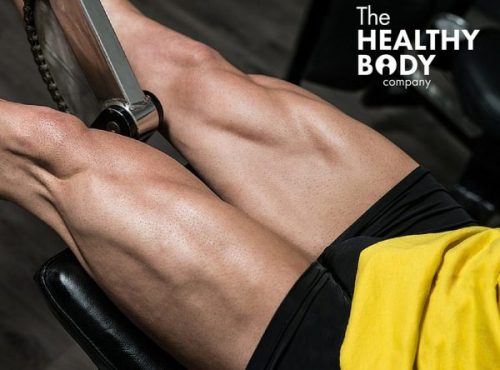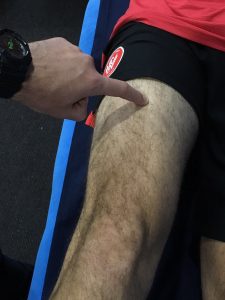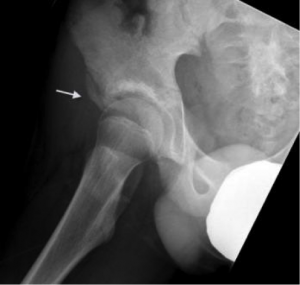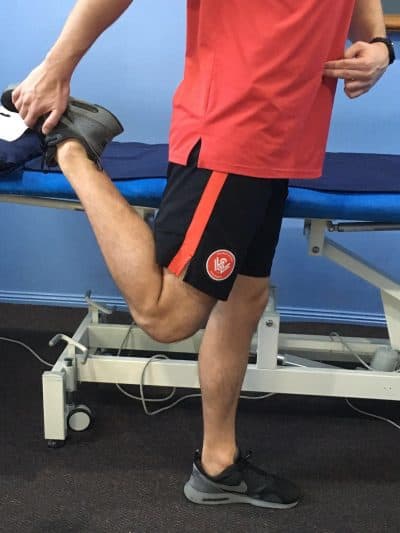
Whether you play AFL, rugby union, rugby league or soccer, you have to be able to kick the ball with skill, precision and power. A great kick can be the difference between losing or winning a game – something we have seen frequently in some recent Rugby League and Champions League games. But the kicking action – bringing your leg backward, then accelerating it forward rapidly and kicking the ball, will put strain on the musculus rectus femoris, which is a part of the big muscle on the front of the thigh, the musculus quadriceps (commonly called the quads).

Rectus Femoris
The quads consists of four muscles, the vastus lateralis (VL), vastus medialis obliques (VMO), vastus intermedius (VI) and the rectus femoris (RF). The first three mentioned muscles extend the knee but the rectus femoris is the only part of the quad that works over both the knee joint and also the hip joint as it is attached to the ilium (pelvic bone)- that bony part that sticks out of your hip. All four parts of the quadriceps muscle attach to the top of the patella (the knee cap) via the quadriceps tendon. The innervation comes from the femoral nerve which comes from the lumbar spine (lower back).
Injury to the rectus femoris usually involves a forceful movement such as explosively sprinting or forcefully kicking a ball (especially when the athlete’s foot strikes another player whilst trying to kick). You can also injure the rectus femoris with other explosive movements as occur in athletics or gymnastics. Even excessive stretching or fatigue due to overuse or simply not having enough recovery time can also result in injury. The rectus femoris seems to be the most commonly injured part of the quad, mainly because of it functioning over both the knee and hip. Injuring the quads can be painful and debilitating and therefore can result in lost time from training and sporting events.
A rectus femoris injury can occur anywhere in its structure, including closer to the knee cap, in the mid section of the muscle or closer to the hip (ilium). The exact location of the injury can be isolated by your health professional.
On injury the athlete will usually notice a sudden sharp pain and loss of function, however these symptoms can sometimes present after the activity, up to several days later. Loss of function can mean limping off the field, not being able to weight bare or experiencing pain when bending the knee. There can be tightness, swelling, loss of range of motion in either the knee or the hip joint and bruising.
A physiotherapist can assess what grade your injury is. We use a grading system that ranges from 1 to 3.
Grade 1: mild to moderate pain on touching (palpating) the injured area, with minor tearing of muscle fibers and none or minimal loss in strength. Usually a you can still weight-bare or walk with a limp. The prognosis is good and you will be able to return to sport within a reasonable amount of time.
Grade 2: moderate to severe pain when touching the affected area. Palpable defect in the muscle or tendon. There is significant tearing of muscle fibres/bundles and reduced muscle strength. You would need support to offload the injury as weight-bearing puts too much strain on the injured site. The prognosis can still be good but it will take more time, depending on the severity, to get back to sporting activities.

Grade III Rectus Femoris Strain
Grade 3: complete tearing of the muscle with associated (severe) pain and completeloss of strength. When touching the affected area a defect can be felt and sometimes even be seen. May be associated with a piece of bone being torn off the pelvis. This type of fracture is called a Anterior Inferior Iliac Spine Avulsion (AIIS). An operation is usually not necessary as conservative treatment can be sufficient.
In the acute phase we would recommend you to follow the RICE method. Rest, Ice, Compression and Elevation to reduce the bleeding and swelling into the muscles. This is done for a period of 24 to 72 hours. Resting the muscle will help reduce the change of making the initial injury worse. When using Ice you should put it on for 15 min and repeat every 1-2 hours. Depending on the severity of the injury you might be advised to use crutches to allow appropriate healing. Oral anti-inflammatory medication may be recommended for a maximum of 3 to 7 days.

Rectus Femoris Stretch
After the acute phase a more active phase of rehabilitation is recommended and your physiotherapist will guide this process. Treatment options can be manual therapy, heat treatment, range of motion (ROM) exercises, (functional) strengthening and stretching. Take care when stretching as this should not be done in the acute phase. Stretching and strengthening during rehabilitation should always be done pain free and a warm up should always precede exercises. If you would require imaging (ultrasound, x-ray or MRI) depends on the type and severity of the injury and can also assist in predicting the length of rehabilitation.
The knee and hip joint should have pre-injury range of motion and pain free. Muscle length and strength should be close to normal and a physiotherapist can do specific tests and compare to the opposite leg to differentiate the difference. When you are ready to return to sport you can, together with your physiotherapist work out a personalised program to ease back into sport and return to your pre-injury fitness.
Your physiotherapist is also able to give you exercises and stretches to help prevent you getting injured as this would always be much more favourable. During a preventative screening/assessment we look at several things: flexibility of the muscles of the lower back, hip, knee and ankle, joint range of motion of above mentioned joints, Strength and coordination when doing functional exercises, especially the hip and knee and more.
My recommendation is to always warm up thoroughly before a training and playing make sure you do the right strengthening exercises to prevent a quads injury.

Michiel van Straten is a Senior Physiotherapist in our Penrith Practice. He is a keen fan of the round ball game, especially when the players wear orange. He is a keen bushwalker and has written some great articles on the benefits of getting out and about.[/vc_column_text][/vc_column][/vc_row]